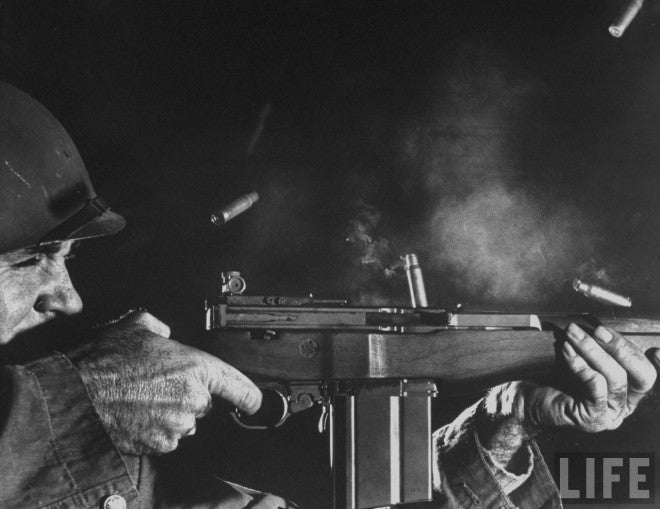This is the zeroeth part of a series of posts seeking to describe and analyze the 7.62mm Light Rifle concept promoted by the Americans, and subsequently adopted by NATO in various forms. This series will cover development from before World War II to the present day, but will focus primarily on the period from 1944-1970, which constitutes the span of time from the Light Rifle’s conception until its end in the United States with the standardization of the M16.
You can read the other parts of the series by following the links below:
- The Rise And Fall Of The Light Rifle, Part I: Prologue
- To Challenge A Newly Won Throne: Light Rifle, Part II
- Improving The Deadliest Rifle In The World: The M1E Series (Light Rifle, Part III)
- Light Rifle, Part IV: The M1 Garand Learns To Rock And Roll
My series of posts on the history of the light rifle is ambitious, by the standards of the blogging I’ve so far done. I seek to cover the concept from the pre-WWII-era to the 1960s and beyond. However, I’ve already made a mistake that has become increasingly apparent over the past two months since I released the first installment, and that is I haven’t adequately outlined what I mean by “Light Rifle”. This post, which will be brief, will clarify that for my readers what exactly I mean, and why I decided to write this series. It’s important for me to avoid overly formal definitions, because I want to preclude semantic arguments over whether Rifle X or Y was or was not a light rifle, and this is why the first article lacks any such definition – a decision that in retrospect was a mistake.
“Light Rifle”, then, refers to the weapons created as a product of the post-WWII US Army effort to field a successor to the M1 Garand. This was called the Lightweight Rifle Program, and it sought to field a rifle in the requisite .30 Light Rifle caliber (which later became 7.62mm NATO) with select-fire capability, and an unloaded weight of seven pounds of less. Therefore, the two weapons that most clearly approach this requirement are Early Harvey’s T25 rifle – which came very close to that weight figure – and Armalite’s later AR-10, which virtually met it. Both weapons pushed the envelope of what could be done with the technology of the period, but both fundamentally fell short as practical weapons due to the 7.62mm cartridge – an immovable requirement for NATO nations at the time. The most successful rifles in the caliber, the M14, FAL, and G3, were at least a pound and a half heavier, but rightly speaking they too are “light rifles” since they ultimately come from the same set of requirements.
It is not the term I would have chosen for these weapons – for a start, it is a name recycled from the program that eventually led to the M1 Carbine, a truly lighter weapon than the M1. Further, the rifles that resulted from the program were hardly light: Many, especially the FAL, would get a reputation for being some of the heaviest and most unwieldy standard infantry rifles ever fielded, though at least some of that was due to their comparison with later, much lighter rifles and contemporary submachine guns.
The idea for this series of articles came from my first time shooting a fully automatic AR-10 rifle (the rifle, and the experience I had shooting it will both be discussed in later installments). The absolutely torrential recoil of that firearm solidified for me the reality that the Lightweight Rifle Program was doomed right from the start, and that piqued my curiosity. Shouldn’t it have been obvious that those goals would never be met? Why did the program take so long and produce what was essentially a product-improved Garand, especially when the private sector came closer in a fraction of the time? These questions and others led me to find every book I could on the subject, and each book I read raised more questions to be answered by others until finally I had read a stack of books that pound for pound might as well have been a stack of rifles. I’m still reading them for the second, third, and in some cases fourth times, and have put wear and tear on each from shuffling a (still plenty heavy) fraction of them at a time through airports across the country, from BWI to Love Field to McCarren.
In those books I didn’t find many easy answers, and that’s why the Light Rifle series will be so long and requires so much time to complete. For my readers, though, there is plenty to look forward to. The second and third posts are well on their way to completion, and in total I am expecting to put out at least ten posts in the series. They will be as follows (keep in mind that they are listed with working titles, and the order is not definite):
Light Rifle I: Prologue
Light Rifle II: Improving The M1 Rifle
Light Rifle III: The .280 British
Light Rifle IV: The .30 Light Rifle
Light Rifle V: The NATO Rifle Trials
Light Rifle VI: The Light Rifle Paradox
Light Rifle VII: Shooting The AR-10
Light Rifle VIII: The Fall of The Light Rifle
Light Rifle IX: The Light Rifle In The 21st Century
Light Rifle X: A Retrospeculative
I hope my readers can be patient, since this project has really gone beyond what I’ve done before in terms of research. Having said that, watch out for the second installment over the next few weeks!
 Your Privacy Choices
Your Privacy Choices
